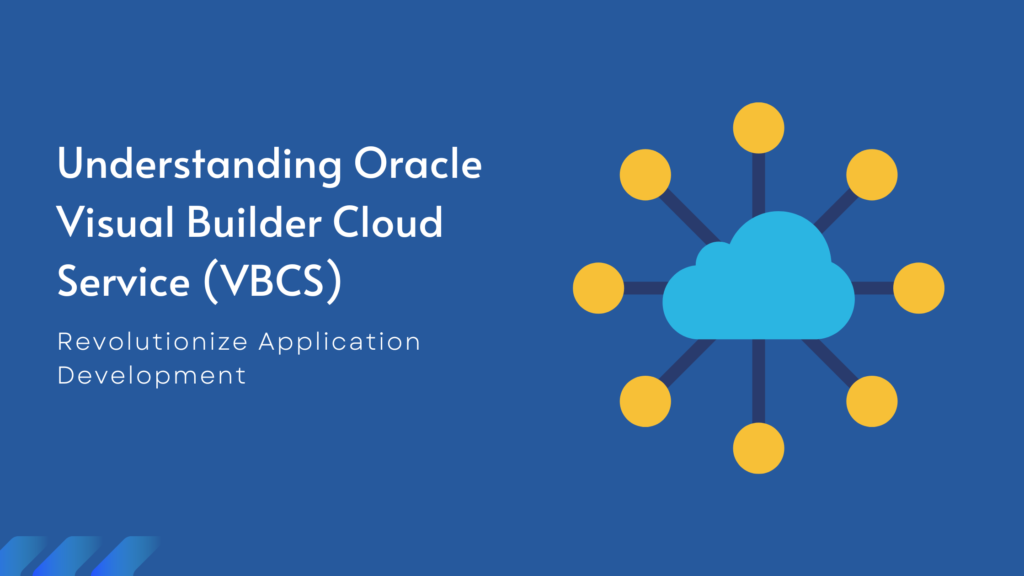Developing Web Applications with Oracle Visual Builder Cloud Service (VBCS): A Comprehensive Guide with Examples

In today’s dynamic business landscape, agility is the name of the game. Organizations need to rapidly respond to market changes, innovate, and deliver exceptional user experiences. Oracle Visual Builder Cloud Service (VBCS) emerges as a game-changer, empowering businesses of all sizes to streamline application development and drive digital transformation. In this comprehensive guide, we’ll take a deep dive into VBCS, exploring its features, benefits, real-world examples, and how to get started.
What is Oracle Visual Builder Cloud Service (VBCS)?
Oracle Visual Builder Cloud Service (VBCS) is a cutting-edge cloud-based development platform that empowers developers and business users to create modern web and mobile applications with ease. It combines the power of visual development tools, pre-built templates, and robust backend services to accelerate application development.
Key Features and Benefits:
- Drag-and-Drop Interface: VBCS offers an intuitive, drag-and-drop interface, enabling users to design applications visually, reducing the need for extensive coding.
- Integration Capabilities: Seamlessly integrate with other Oracle Cloud services, third-party APIs, and on-premises systems, ensuring your applications can access and leverage data from various sources.
- Mobile-Friendly: Create responsive web and mobile applications, guaranteeing a consistent user experience across devices.
- Security: VBCS prioritizes security, offering robust authentication and authorization controls to protect your applications and sensitive data.
- Scalability: As your business grows, VBCS scales effortlessly, handling increased workloads and user demands without disruptions.
Getting Started with VBCS:
Are you ready to embrace the future of application development? Here’s a step-by-step guide to kickstart your journey with VBCS:
In this example, we’ll create a basic to-do list web application. Follow these steps:
Step 1: Sign In to Oracle Cloud
Log in to your Oracle Cloud account.
Step 2: Access VBCS
Navigate to the Oracle Visual Builder Cloud Service dashboard.
Step 3: Create a New VBCS Project
- Click “Create Application” and choose “Web Application.”
- Name your project (e.g., “ToDoApp”) and click “Create.”
Step 4: Design Your Web App
- Use the drag-and-drop interface to create a simple user interface for your to-do list.
- Add buttons, input fields, and labels.
Step 5: Define Business Logic
- Create a JavaScript function to add tasks to the list.
- Implement a function to mark tasks as completed.
- Add code to remove completed tasks.
// Sample JavaScript for adding a task
function addTask() {
var taskText = document.getElementById(‘taskInput’).value;
if (taskText) {
var taskList = document.getElementById(‘taskList’);
var taskItem = document.createElement(‘li’);
taskItem.textContent = taskText;
taskList.appendChild(taskItem);
}
}
Step 6: Deploy Your Web App
- Test your web application within the VBCS environment.
- Once satisfied, deploy it to your desired environment (e.g., Oracle Cloud).
Step 7: Access Your Web App
Your to-do list web application is now live and accessible via a web URL.
Example 2: Integrating with Oracle Cloud Services
Now, let’s enhance our to-do list app by integrating it with an Oracle Cloud Database for task persistence.
Step 1: Create an Oracle Cloud Database
- Access the Oracle Cloud Console.
- Set up a new Oracle Cloud Database to store task data.
Step 2: Configure Data Integration
- In VBCS, navigate to “Data” and set up a connection to your Oracle Cloud Database.
Step 3: Modify Your Application Logic
- Update your JavaScript functions to fetch and store tasks in the database.
// Sample JavaScript for adding a task (with database integration)
function addTask() {
var taskText = document.getElementById(‘taskInput’).value;
if (taskText) {
// Save the task in the database
// …
}
}
// Sample JavaScript for loading tasks from the database
function loadTasks() {
// Fetch tasks from the database and display them
// …
}
Step 4: Redeploy Your Web App
After making the necessary changes, redeploy your web application to apply the updates.
Conclusion
Developing web applications with Oracle Visual Builder Cloud Service (VBCS) is a streamlined and efficient process, thanks to its visual development environment and robust features. Whether you’re building a simple to-do list app or a complex enterprise solution, VBCS empowers you to bring your ideas to life. Start your journey today, explore its capabilities, and transform your web development experience.

Leave a Reply